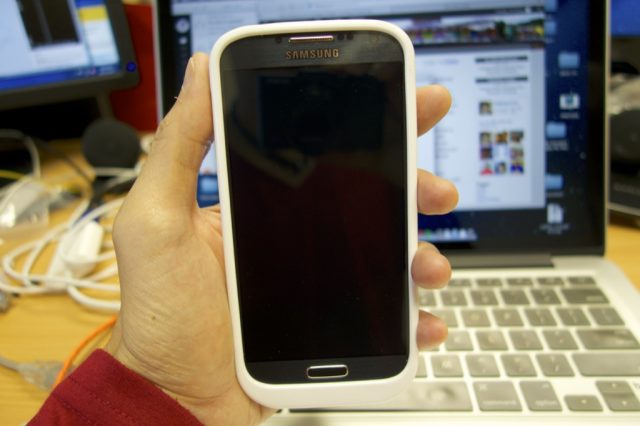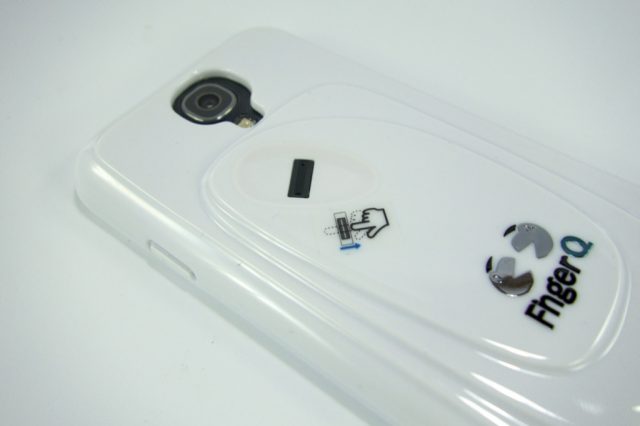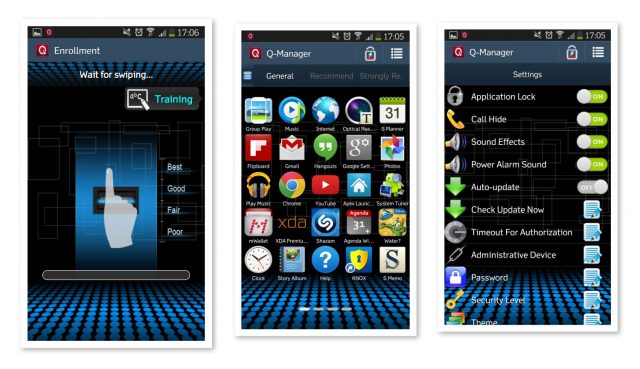
One of the highlights of the recently launched iPhone 5S is its fingerprint sensor, aka Touch ID. The Android world also has the HTC One Max with a fingerprint sensor on its back. Now, if you fancy this new security feature, but you have some other sort of Android phone, what are your options? Well, FingerQ has a solution for you.
FingerQ makes a number of fingerprint sensor accessories that you can add-on to your existing Android phones. There are two types of accessories. One type takes the form of a generic microUSB key, and the other is a custom moulded case designed for specific phone models. The one pictured above, for example, is the PrivacQ Q-Case for the Samsung Galaxy S4.
My first impression about the PrivacQ Q-Case is that, oh my, it’s a really big bumper case. The Galaxy S4 is already quite big, this made it much more so. It’s a pity that there’s no battery bank embedded into the bumper. There’s just the fingerprint sensor on the back.
Unlike the Touch ID which sits on top of the iPhone 5S’ home button, the fingerprint sensor on the PrivacQ Q-Case is on the back of the bumper. There’s a practical usefulness for the sensor to be there, and I’ll say why later.
The way PrivacQ reads your fingerprint is unlike the way the Touch ID works. With Touch ID, you just place your finger on the sensor. In the case of PrivacQ, it’s like how fingerprint readers on some notebooks work. You have to slide your finger across the reading sensor.
Once you’ve installed the Q-Case, you’ve got to download its companion app, the Q-Manager from the Google Play store. Fire up Q-Manager, and register your fingerprint. PrivacQ Q-Case seems to do a reasonably good job at verifying fingerprints. Not speedy like Touch ID, but it’ll do.
Using the Q-Manager, you can lock any app. This means that to launch such apps, Q-Manager will require to scan your fingerprint. Successful verification of your fingerprint lets you launch the app. You can use the Q-Manager to lock all the “sensitive” apps, or apps that access your highly confidential data.
The big thing that’s missing in Q-Manager, however, is the ability to lock the phone itself. It won’t replace the lock screen password. I thought this was such a big disappointment. I imagined the best thing to do was to prevent anyone from even trying to use my phone.
So, considering that you don’t use your fingerprint to unlock the phone, but instead only use it to launch apps while your phone is already unlocked, it makes sense that the reader is placed on the back of the Q-Case. In fact, it is so strategically placed that you’ll find your index finger just naturally positioned over the reader, at least when you use the phone with your left-hand.
The Q-Manager is not pretty in my books. Too many apps try to look spectacular, but I rather the apps just gel with the user interface styles of their host platform. Nevertheless, the Q-Manager is completely functional and easy to use.
FingerQ also makes Q-Cases for several other phone models. They are: Samsung Galaxy S3, Samsung Galaxy Note II and HTC One. If you don’t have any of these phones, you can still use the generic microUSB dongle version, known as the Q-Key.
 The Q-Key looks different, but functionally it’s entirely the same as the Q-Case. It connects via microUSB port.
The Q-Key looks different, but functionally it’s entirely the same as the Q-Case. It connects via microUSB port.
The Q-Key is also available in a version with an Apple 30-pin interface, so you can use it with older iPhones. Yes, it does come with an iOS version of Q-Manager, of course.
Conclusion
These fingerprint reading gadgets are not cheap. The Q-Case sells for S$119, and the Q-Key is S$79. But I suppose if your app or data security is so important, you might be able to justify the expense.
Pros:
- Easy to use
- Fingerprint verification works well
- Per-app locking granularity
Cons:
- Bumper case is bulky
- Relatively costly
- Doesn’t lock the phone itself



View Comment Policy